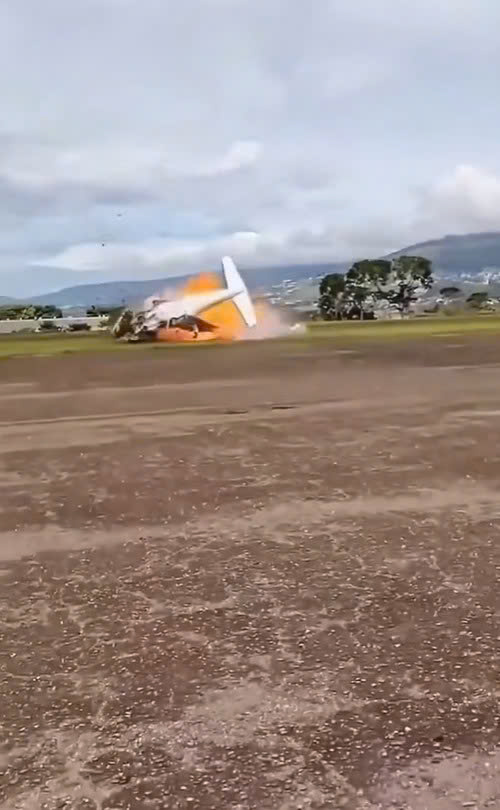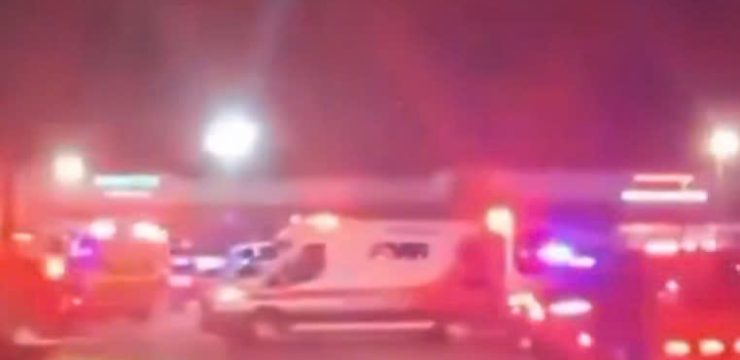It began as a calm, routine morning in San Cristóbal, Venezuela. The sun had just risen over the Andes, painting the sky in shades of gold and pale blue, as airport personnel at Paramillo Airport prepared for another day of flights. Among them was a Piper PA-31T1 Cheyenne, a sleek twin-engine aircraft registered as YV1443, set for a standard morning departure. Nothing about the scene suggested that tragedy was just moments away. Witnesses recall watching the plane taxi confidently down the runway, engines humming steadily. Yet, within seconds of takeoff, that hum turned into a sputter. The aircraft struggled to gain altitude, wobbling dangerously as it climbed a few dozen feet before losing lift altogether. “It looked like it was fighting to stay in the air,” one bystander said. Then came the sound no one will ever forget—a thunderous crash followed by an eruption of flames that sent black smoke curling into the sky.

Emergency sirens wailed as firefighters and rescue teams rushed toward the wreckage, their vehicles kicking up dust along the tarmac. The aircraft had gone down just beyond the runway perimeter, its fuselage engulfed in fire. Despite the heroic efforts of first responders who battled the blaze and worked frantically to reach the cockpit, it was too late. Both pilots were pronounced dead at the scene. Authorities from the National Institute of Civil Aeronautics (INAC) confirmed that the crash occurred at approximately 9:52 a.m. on Wednesday morning, only moments after the plane lifted off. The victims’ names were withheld pending notification of their families.
INAC released an official statement expressing its deep condolences to the victims’ loved ones and announced that the Civil Aviation Accident Investigation Board (JIAAC) had launched a full inquiry into the cause. The initial findings offered few clues. Weather conditions had been clear and stable, with no reported turbulence or visibility issues. The aircraft, which had recently undergone its routine maintenance checks, appeared to be in satisfactory condition. Investigators immediately began collecting flight data, examining engine components, and reviewing the pilots’ communication logs with air traffic control. Mechanical malfunction, fuel irregularities, or human error—all were being explored as possible causes.
Residents living near the airport described the terrifying moments leading up to the crash. “We heard the engines stutter like they were losing power,” said one local. “Then, for a few seconds, everything went silent. The next thing we knew, there was an explosion.” The blast rattled windows in nearby homes, but thanks to the swift work of firefighters, the flames were quickly contained, preventing further destruction or injury. No one on the ground was harmed, and fuel tanks located within the airport remained secure—an outcome authorities credit to the efficiency of the emergency response teams.
The aircraft involved, the Piper PA-31T1 Cheyenne, is known for its reliability in both commercial and private aviation. However, experts note that even the best-maintained planes can experience sudden technical failures. “In aviation, every second matters,” said one Venezuelan pilot familiar with the model. “If a mechanical issue arises during takeoff—the most critical phase of flight—there’s very little time to react.” Aviation analysts in Caracas have also highlighted that the Paramillo Airport’s elevation and surrounding terrain can present additional challenges for smaller twin-engine planes, particularly if they lose engine power after takeoff.
As the investigation progresses, the tragedy has reignited nationwide discussions about aviation safety standards and oversight within Venezuela’s regional airports. In recent years, several smaller airports have faced scrutiny for aging infrastructure and limited emergency preparedness resources. However, this incident also revealed the strength and dedication of the country’s first responders, whose coordinated actions prevented what could have become a far larger disaster. “They were on the scene in less than two minutes,” said an INAC spokesperson. “Their training and discipline saved lives and property.”
Grief now hangs heavy over Venezuela’s aviation community. Fellow pilots, engineers, and air traffic controllers across the nation have expressed sorrow and solidarity. Tributes have poured in on social media, with colleagues sharing memories of the two pilots’ professionalism and passion for flying. “They loved what they did,” one friend wrote. “They gave their lives doing what they believed in—ensuring people could travel safely.” Local media outlets have also emphasized how their deaths underscore the inherent risks of flight operations and the importance of continued investment in maintenance, training, and safety oversight.
Preliminary evidence recovered from the crash site includes fragments of the engines and flight instruments that will be analyzed in laboratories. The data retrieved from these components could be crucial in determining what caused the catastrophic loss of power. “Every accident tells a story,” noted one aviation investigator. “Our job is to find that story and make sure it doesn’t repeat itself.” The JIAAC has pledged transparency throughout the process, promising regular updates to the public and the victims’ families.
In the days following the crash, the wreckage of YV1443 has been cordoned off behind barriers, guarded by airport police. Flowers and handwritten notes have begun to appear near the site—small gestures from colleagues and community members who continue to grieve. One note, taped to the fence, reads simply: “Thank you for flying our skies. Rest in peace.” For many, this tragedy is a stark reminder that aviation, though one of the safest modes of travel, carries risks that demand constant vigilance.
As Venezuela mourns, officials hope that the investigation’s findings will not only provide closure to grieving families but also lead to stronger safety protocols for the future. There is growing consensus among experts that this should serve as a turning point for regional airport safety—prompting reviews of maintenance records, flight crew training, and emergency response systems. “Every life lost in the air teaches us something,” one retired pilot remarked. “The question is whether we’ll listen.”
For now, the blackened remnants of the twin-engine aircraft at Paramillo stand as a somber symbol—a scene of tragedy and reflection. Two dedicated aviators set out to complete a simple morning flight but never returned. Their final journey serves as a reminder of the courage, precision, and responsibility that every pilot carries each time they step into the cockpit. The skies above Venezuela remain filled with determination and hope, but also with a renewed call for safety, transparency, and respect for the lives of those who make flight possible.





